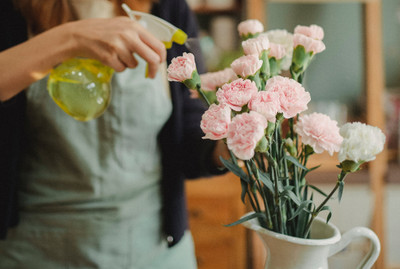Flower Guide: Tips for Keeping Your Blooms Fresh and Vibrant
Jul 30th 2019
Water Wisely
Fresh flowers need water at all times, as they continue to "drink" even after being cut. Avoid exposing your flowers to air; it may cause water-absorbing cells in the stem to shrivel, which shortens the bouquet's life. Daily, add fresh, room temperature water mixed with flower food provided with your bouquet. Avoid using home remedies like aspirin, bleach, mouthwash, or lemon-lime soda. Most wilted flowers can be revived by submerging the entire stem up to the flower head in warm water for 10 minutes.
CUT STEMS AT AN ANGLE
Every few days, trim fresh flower stems diagonally under running water (using a knife instead of scissors is ideal). This prevents the stems from sitting flat on the vase's bottom and blocking water uptake. Cutting stems vertically destroys cell structure, promotes bacteria growth, and hinders water absorption.
PRUNE DAILY
Remove submerged leaves in your vase, as they rot and create bacteria that can shorten your bouquet's life. Prune dead blossoms to encourage other blooms to open. As flowers wither, remove them from the bouquet and move the remaining blooms to a smaller vase.
Avoid Heat and Drafts
Place your flowers away from heat-generating appliances, direct sunlight, and drafts like fans. High temperatures and sunlight cause flowers to mature faster, shortening their lifespan.
Allergies, Sensitivities, and Pet Safety
For those with allergies or sensitivities to flower fragrance, choose tropical flowers like orchids, anthurium, birds of paradise, or other tropical varieties. Avoid strongly fragranced Oriental lilies, particularly Stargazer lilies. Some Passion Rose varieties are fragrance-free or slightly fragranced. Toxic varieties for animals include lilies, palms, tulip bulbs, narcissus bulbs, azaleas, rhododendrons, cyclamens, kalanchoes, amaryllises, chrysanthemums, English ivy, and peace lilies.
ABOUT FLOWERS

Roses are possibly the most beloved of all flowers. Yourroses may arrive with guard petals surrounding the outside of the blooms. These petals are left on to protect the blooms during shipment and should be removed to increase the beauty of yourrose bouquet. Roses are thirsty flowers, so check them daily to make sure they have enough water. If a rose wilts and becomes limp, remove it from the bouquet and re-cut the stem under running water. Re-hydrate the flower in room temperature water mixed with flower food (provided with your bouquet) until the rose bloom becomes firm. The rose can then be returned to the bouquet.
Colors:
Red, White, Pink, Fuchsia, Lavender, Jade, Cream, Peach, Yellow, Orange, Burgundy and plenty of bi-colored varieties.

There are three main types of lilies: Asiatic, Oriental and LA Hybrid.Asiatic lilies tend to have smaller blooms, but come in a vast array of colors. Oriental lilies have large blooms, a stronger fragrance and tend to last longer than other varieties. LA hybrid lilies have medium-sized blooms and tend to outlast Asiatic lilies. As blooms unfold, be careful not to touch the pollen on the flowers' anthers because it can stain upholstery and clothing. To prevent this from happening, some people choose to remove the pollen by carefully wiping it off with a tissue, or they clip off and discard the anthers altogether. If pollen does get on fabric, let it dry in the sun then try lifting it with cellophane tape, a cotton swab or a soft cloth. You can also try a household fabric stain remover or dry cleaning. Never wipe it with water as that will set the stain.
Colors: White, Pink, Yellow, Orange, Burgundy

Birds of paradise and anthurium last longest in moderate temperatures. Mist blooms with cool water, as they drink from both stems and blooms. Many tropical flowers drink in water not only from their stems but also directly through their blooms. Therefore, in addition to keeping them properly hydrated, you should also mist them with cool water, especially upon arrival.
Colors:
Wide-ranging.

Sensitive to fluoride, use distilled water if possible. Leave protective straws on stems for 4-5 hours during initial hydration. Re-cut stems every few days.
Colors:
White, Red, Yellow, Orange, Pink, Peach, Fuchsia and some bi-colored varieties.

The picture of elegance, these unique flowers can bloom in either full or miniature sizes and also in a variety of colors.
Handle blooms delicately to avoid bruising. Place an elastic band around each lily stem during the first hour of hydration to prevent air from entering.
Colors:
White, Yellow, Flame Orange, Plum, Lavender, Pink, Green
and Peach.

Orchids are the most complex, advanced and successful family of flowers on the planet, with approximately 25,000 species occurring naturally throughout the world. Orchids are sensitive to sun, heat and drafts, so be sure and display your orchid arrangement away from direct sunlight, heat-generating appliances and fans. Since orchids drink in water not only from their stems but also directly through their blooms, you should also mist them with cool water, especially upon arrival.
Colors:
White, Pink, Yellow, Orange, Burgundy

